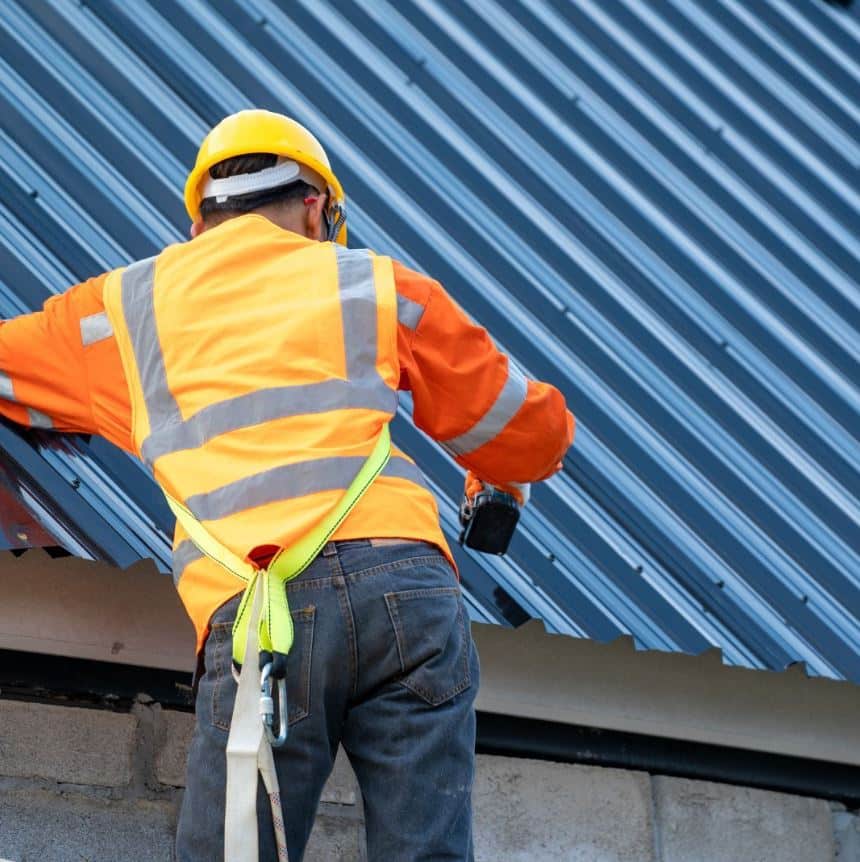To weatherproof your home, start with the roof, directly exposed to harsh elements. Before extreme conditions like hurricanes, proper preparation through detailed maintenance and professional inspections is crucial to prevent significant damage. This goes beyond simple checks to include cleaning gutters, trimming nearby tree branches, securing loose items, and evaluating your insurance coverage. A thorough assessment by a professional roofer is essential, as damages like missing shingles or cracks often go unnoticed from below.

Key Takeaways
- Adequate roof preparation is vital for weatherproofing your home and preventing severe damage.
- Professional roof inspections can identify minor issues before they become major problems.
- Additional steps like cleaning gutters and trimming trees are essential parts of storm damage prevention.
- Review your insurance policy to ensure it covers potential roof damage due to harsh weather.
- Take proactive measures to prevent damage instead of waiting to repair it – prevention is always better than cure.
The Importance of Preparing Your Roof
Ensuring your home withstands various weather conditions is crucial for its well-being. Proper roof preparation reduces damage and extends its life. Understand how weather impacts your roof, and explore common issues and weatherproofing strategies. Learn about DIY roof repairs and severe weather preparations for optimal protection.
How Different Weather Conditions Affect Your Roof
Different weather scenarios can contribute to severe weather roof damage in unique ways. In sunny climates, your roof is exposed to relentless ultraviolet rays that can lead to shingle degradation and paint wear. High-wind environments can launch debris into your roof, causing extensive damage. Furthermore, particularly heavy rain can lead to water backup and leakage into the home, especially with blocked or faulty gutters and downspouts. The winter season brings its own challenges—ice dams and heavy snowfall can compromise the roof’s structure, creating a pressing need for roof repair solutions.
The Cost of Neglect vs. The Benefits of Preparation
When you neglect the job of preparing your roof, the cost can exceed the benefits of regular preparation and upkeep. An ill-prepared roof can lead to serious issues such as interior water damage and structural failures, making roof renovation ideas an expensive proposition in the long run. On the contrary, investing time and resources in preparing your roof and following hurricane damage prevention and hail impact resistance guidelines pays off in the long run. The benefits of roof preparation work include a reduced risk of weather-related damage, fewer emergency repairs, and the potential for a longer-lasting roof.

| Cost of Neglect | Benefits of Preparation |
|---|---|
| Interior water damage | Reduced risk of weather-related damage. |
| Structural failures | Fewer emergency repairs are required. |
| Increase in repair costs over time. | Potential for a longer-lasting roof. |
Taking proactive measures, such as performing regular inspections, maintaining adequate drainage for flat commercial roofs, inspecting for damage, checking flashings and metal detailing, and preventing pitch pocket failures, all contribute towards a better-maintained, more weather-resistant roof.
Preparing Your Roof: A Comprehensive Checklist
Preparing your roof for severe weather is essential. Our guide highlights key steps such as regular inspections to check for damage, securing seals, and keeping gutters clean. It’s important to choose durable materials and add wind mitigation features like wind straps. Installing waterproof underlayments and proper attic insulation, managing tree growth, and having an emergency plan with roof tarps are crucial. Ensure comprehensive insurance coverage and seek professional advice to strengthen your roof and ensure your home’s safety.

FAQs
How do I prepare my roof for severe weather?
You can start by conducting a thorough inspection of your roof for potential vulnerabilities, like missing or damaged shingles, cracked tiles, and signs of wear and tear. Cleaning gutters and downspouts, trimming trees, and securing loose items around the house are also important steps. If a storm is imminent, you might want to stock up on tarps to make any necessary emergency temporary repairs. When the weather is calm, routine roof maintenance and professional roof inspections are advisable to ensure your roof remains in good condition.
What different weather conditions can affect my roof, and how?
Different weather conditions can impact your roof. The sun can degrade shingles and wear down paint, wind can cause debris to damage the roof, and rain can cause water to back up onto the roof, especially if gutters or downspouts are blocked and leak into homes. In winter, the weight of heavy snow can damage the roof’s structure, while ice dams can trigger interior leaks.
What are the costs of neglecting roof preparation vs. the benefits of roof preparation?
Neglecting your roof may lead to severe issues, including interior water damage and structural failures, which can significantly increase repair costs. On the other hand, the benefits of roof preparation include reduced risk of damage, fewer emergency repairs, the potential for longer-lasting roofs, and peace of mind during severe weather. Regular roof inspections, checking flashings and metal detailing, removing blockages from gutters, and performing maintenance checks are proactive measures to help you benefit fully from your roof preparation efforts.
What should be on my roof preparation checklist?
Preparing your roof should include regular roof inspections, checking that all seals around vents and chimneys are functioning well, that gutters and downspouts are clear of obstructions, and that your roofing materials (like shingles or metal roofing) are durable and properly fastened. An effective checklist also includes wind mitigation techniques, such as installing wind straps or clips, and preventive measures against water and ice damage like waterproof underlayments and appropriate ventilation. Managing tree growth and debris can help reduce the risk of storm damage.
What should I do in case of emergency roof damage?
In the event of emergency roof damage, you should have a plan ready. This might include a method to quickly cover the damaged area with tarps, contact information for professional residential roofers, and a comprehensive homeowners’ insurance policy. These preparations can help mitigate damage and provide peace of mind.


